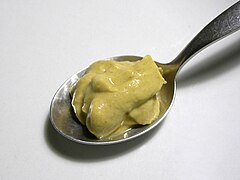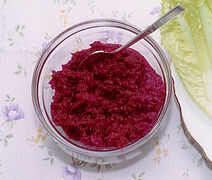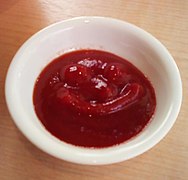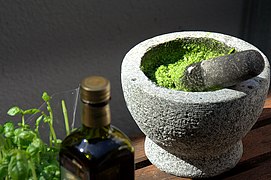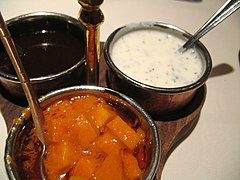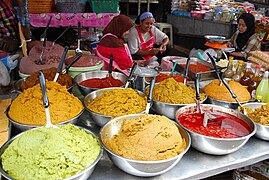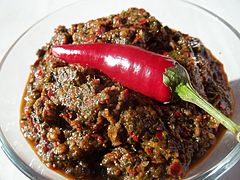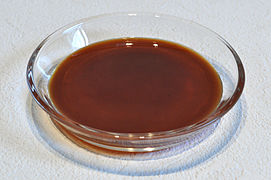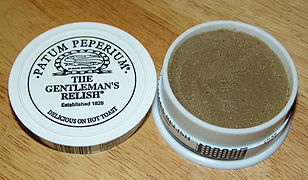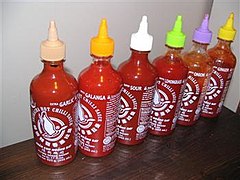Condiment
The examples and perspective in this article may not represent a worldwide view of the subject. (March 2015) |

A condiment is a spice, sauce, or preparation that is added to food, after cooking, to impart a specific flavor, to enhance the flavor,[1] or to complement the dish. A table condiment or table sauce is more specifically a condiment that is served separately from the food and is added to taste by the diner.
Condiments are sometimes added prior to serving, for example, in a sandwich made with ketchup, mustard or mayonnaise. Some condiments are used during cooking to add flavor or texture: barbecue sauce, compound butter, teriyaki sauce, soy sauce, marmite and sour cream are examples.
Many condiments, such as mustard or ketchup, are available in single-serving packets, commonly when supplied with take-out or fast-food meals.
Definition


The exact definition of a condiment varies. Some definitions encompass spices and herbs, including salt and pepper,[2] using the term interchangeably with seasoning.[3] Others restrict the definition to include only "prepared food compound[s], containing one or more spices", which are added to food after the cooking process, such as mustard, ketchup or mint sauce.[3] Cheese is also considered a condiment in some European countries.[citation needed]
Etymology
The term condiment comes from the Latin condimentum, meaning "spice, seasoning, sauce" and from the Latin condire, meaning "preserve, pickle, season".[4] The term originally described pickled or preserved foods, but its meaning has changed over time.[5]
History
Condiments were known in Ancient Rome, Ancient India, Ancient Greece and Ancient China. There is a myth that before food preservation techniques were widespread, pungent spices and condiments were used to make the food more palatable,[6] but this claim is not supported by any evidence or historical record.[7] The Romans made the condiments garum and liquamen by crushing the innards of various fish and then fermenting them in salt, resulting in a liquid containing glutamic acid, suitable for enhancing the flavor of food. This process would lead to a flourishing condiment industry.[4] Apicius, a cookbook based on fourth and fifth century cuisine, contains a section based solely on condiments.[4]
List of condiments
Market in the United States
In the United States, the market for condiments was US$5.6 billion in 2010 and is estimated to grow to US$7 billion by 2015.[8] The condiment market is the second largest in specialty foods behind that of cheese.[8]
Gallery
-
Chrain (horseradish sauce)
-
Ajika, spicy sauce in Caucasian cuisine
-
Packets of duck sauce
See also
- Condiments by country (category)
- Dip – Type of sauce
- Garnish – Decoration added to food or drink
- List of fish sauces
- List of foods – List of lists of food products
- List of mustard brands
- Non-brewed condiment – Malt vinegar substitute
- Seasoning – Process of supplementing food via herbs, salts, or spices
- Spice – Food flavoring
- Relish – Cooked, pickled, or chopped vegetable or fruit used as a condiment
- Ingredient – Part of a mixture
References
Citations
- ^ Merriam-Webster: Definition of condiment
- ^ Collins: Definition Condiment
- ^ a b Farrell, p. 291
- ^ a b c Nealon
- ^ Smith, pp. 144–146
- ^ Farrell, p. 297
- ^ According to Paul Freedman, the idea is presented as a fact even by some modern scholars, despite the lack of any credible support; Freedman (2008), pp. 3–4
- ^ a b Sax, David (October 7, 2010). "Spreading the Love". Bloomberg Businessweek. Retrieved 9 October 2010.
Sources
- "Collins: Definition Condiment". Collins Dictionary. n.d. Retrieved 29 September 2014.
- Farrell, K. T. (1990). Spices, Condiments and Seasonings (2nd ed.). MA, USA: Aspen Publishers. p. 291. ISBN 9780834213371.
- "Merriam-Webster: Definition of condiment". Merriam-Webster Dictionary. Retrieved October 23, 2011.
- Nealon, Tom (7 September 2010). "De Condimentis". HiLobrow. Retrieved 10 February 2014.
- Smith, Andrew F. (May 1, 2007). The Oxford companion to American food and drink. Oxford University Press. ISBN 978-0-19-530796-2. Retrieved March 15, 2012.

